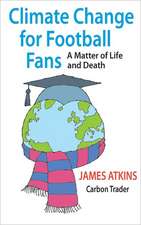QSAR in Environmental Toxicology - II: Proceedings of the 2nd International Workshop on QSAR in Environmental Toxicology, held at McMaster University, Hamilton, Ontario, Canada, June 9–13, 1986
Editat de K.L. Kaiseren Limba Engleză Paperback – 4 oct 2011
Preț: 649.54 lei
Preț vechi: 764.17 lei
-15% Nou
Puncte Express: 974
Preț estimativ în valută:
124.30€ • 134.98$ • 104.42£
124.30€ • 134.98$ • 104.42£
Carte tipărită la comandă
Livrare economică 22 aprilie-06 mai
Preluare comenzi: 021 569.72.76
Specificații
ISBN-13: 9789401082464
ISBN-10: 9401082464
Pagini: 484
Ilustrații: 488 p.
Dimensiuni: 155 x 235 x 25 mm
Greutate: 0.67 kg
Ediția:Softcover reprint of the original 1st ed. 1987
Editura: SPRINGER NETHERLANDS
Colecția Springer
Locul publicării:Dordrecht, Netherlands
ISBN-10: 9401082464
Pagini: 484
Ilustrații: 488 p.
Dimensiuni: 155 x 235 x 25 mm
Greutate: 0.67 kg
Ediția:Softcover reprint of the original 1st ed. 1987
Editura: SPRINGER NETHERLANDS
Colecția Springer
Locul publicării:Dordrecht, Netherlands
Public țintă
ResearchCuprins
Group photograph and outline.- Preface.- List of Participants and Contributors.- A discussion of correlations for narcosis in aquatic species.- Interrelationship between biodegredability, toxicity and structure of chlorophenols.- Structure/ environmental fate relationships.- Bioaccumulation of phenols in zebrafish determined by a dynamic flow through test.- Tissue distribution and elimination of 1,2,3,4-, 1,2,3,5- and 1,2,4,5-tetrachlorobenzene in the rat.- Assessing the administrative utility of the QSAR Information System.- METABOLEXPERT: An expert system for predicting metabolism of substances.- Correlation of biodegradability with atomic charge difference and superdelocalizability.- Prediction of rat oral LD50 from Daphnia magna LC50 and chemical structure.- Factors determining partitioning of hydrophobic organic chemicals in aquatic organisms.- Quantitative structure-activity relationship studies: Acute toxicity of environmental contaminants.- QSAR studies of fish toxicity data of organophosphorus compounds and other classes of reactive organic compounds.- QSAR of acute toxicity of mono-substituted benzene derivatives to Photobacterium phosphoreum.- QSAR of acute toxicity of 1,4-di-substituted benzene derivatives and relationships with the acute toxicity of corresponding mono-substituted benzene derivatives.- Quantitative structure-activity studies of di- and triorganotin compounds.- Relationship between toxicity and bioconcentration for some organic chemicals. I. Examination of the relationship.- Relationship between toxicity and bioconcentration for some organic chemicals. II. Application of the relationship.- Comparison of fish toxicity screening data and QSAR predictions for 48 aniline derivatives.- Partitioning relationships for chlorinated organics between water and particulates in the St. Clair, Detroit and Niagara Rivers.- Quantitative structure- activity relationships (QSAR) and toxicity data in hazard assessment.- Taft sigma and sigma, constants improve log octanol/water partition coefficient based QSAR for fathead minnow toxicity.- The use of luminescent bacteria in the study of structure-toxicity relationships for trichothecenes.- An analysis on published data on fish toxicity of nitrobenzene and aniline derivatives.- Nonempirical modeling of environmental distribution and toxicity of major organic pollutants.- Structure- activity relationships for para-substituted phenols.- Physical-chemical properties of three congeneric series of chlorinated aromatic hydrocarbons.- The relationship between bioaccumulation and lipid content of fish.- Multiparameter correlations between properties of metal ions and their acute toxicity in mice.- Structure-toxicity relationships for industrial chemicals causing type (II) narcosis syndrome.- Influence of life cycle stage on toxicity: The Matacil 1.8D - Chlamydomonas example.- Calmodulin inhibition: A possible predictor of metal-ion toxicity.- Author/Reference Index.- CAS Number Index.- Chemical Formula Index.
Recenzii
`Well written ... clearly printed, being packed with information useful to the environmentalist, as well as investigators into both atmospheric and aquatic pollution problems and, of course, biologists in Water Authority laboratories.'
The Environmentalist, 8:2 (1988)
`In that sense, the book edited by Klaus Kaiser is certainly the most complete presence source concerning the results and problems of environmental toxicology. Value of the collection is highly enhanced by the rich index system completing the book. There is a good chance that the editors' hope (`this book will be of use as a lasting reference source for both freshman and specialist in the field') will come true.'
QSAR, 88/3
The Environmentalist, 8:2 (1988)
`In that sense, the book edited by Klaus Kaiser is certainly the most complete presence source concerning the results and problems of environmental toxicology. Value of the collection is highly enhanced by the rich index system completing the book. There is a good chance that the editors' hope (`this book will be of use as a lasting reference source for both freshman and specialist in the field') will come true.'
QSAR, 88/3






